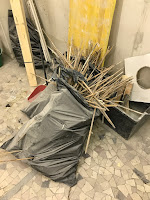The circles of Hell
Men leave no stone unturned when in pursuit of "progress". The consequences rarely matter, even if well documented. In Behemoth (2015), Zhao Liang masterly depicts the working conditions in a coal mine in Inner Mongolia and the destruction of a land that used to be inhabited mainly by nomadic herders. Explosives uncover precious rocks while hundreds of trucks build up new Death Valleys. The hellish noise of the factories plays against the rattle of the many workers dying of occupational lung disease.
Q: Where will we go when no trace of grace is left in the world?
A: What about ghost towns?
Love your neighbour
In 1952, Canadian film-maker Norman McLauren wrote and directed Neighbours. The documentary was produced by the National Film Board of Canada (NFB) and it lasts just eight minutes and six seconds. It won an Oscar and in 2009 was added to UNESCO's Memory of the World Programme, an international initiative launched in 1992 to safeguard the documentary heritage of humanity against collective amnesia, neglect and deliberate destruction.
Norman McLauren, Neighbours, NFB, 1952.
Into the real world
Dear friends and colleagues,
Spazio is getting ready to venture into the real world and start addressing spatially some of the topics discussed here. It is still very much a work in progress but I will soon disclose all the details.
Spazio, new gallery, photographs Mariana Siracusa
Wonderland Vrin
In 1998, the Swiss Heritage Society awarded the village the Wakke Prize for the masterful integration of modern agricultural buildings into its historic fabric. The terrific work by Gion Caminada is well known to architects.
"Vrin. A Village in the Alps." Filmmaker, Marc Schwarz
What impressed me the most when walking around on a cold Sunday morning was the spatial quality that results from carefully siting one building close to the other. The space between has a perfect human scale. Maybe because it was cold and snowing it reminded me of the way animals stand close to each other to stay warm during the winter.
Gion Caminada, House Caminada, 2000
In the 1980s, the municipality purchased all the available building land in other to prevent speculation. It was partly used to build communal offices, a multipurpose hall, a butcher's shop, a telephone booth, agricultural buildings, and a mortuary.
Gion Caminada, Stiva da morts, Community Mortuary Building, 2002
Gion Caminada, Stiva da morts, Community Mortuary Building, 2002
Gion Caminada, Bus Stop, 2015
It is surprising how even the smallest buildings (bus stop and telephone booth) have been perfectly detailed to shelter from and react to snow and wind. During the summer these same buildings will probably reveal a different face.
Photographs, Mariana Siracusa
Further reading
Bettina Schlorhaufer, ed. Cul zuffel e l'aura dado. Gion A. Caminada. Luzern: Quart Verlag, 2008.
Subscribe to:
Comments (Atom)






































